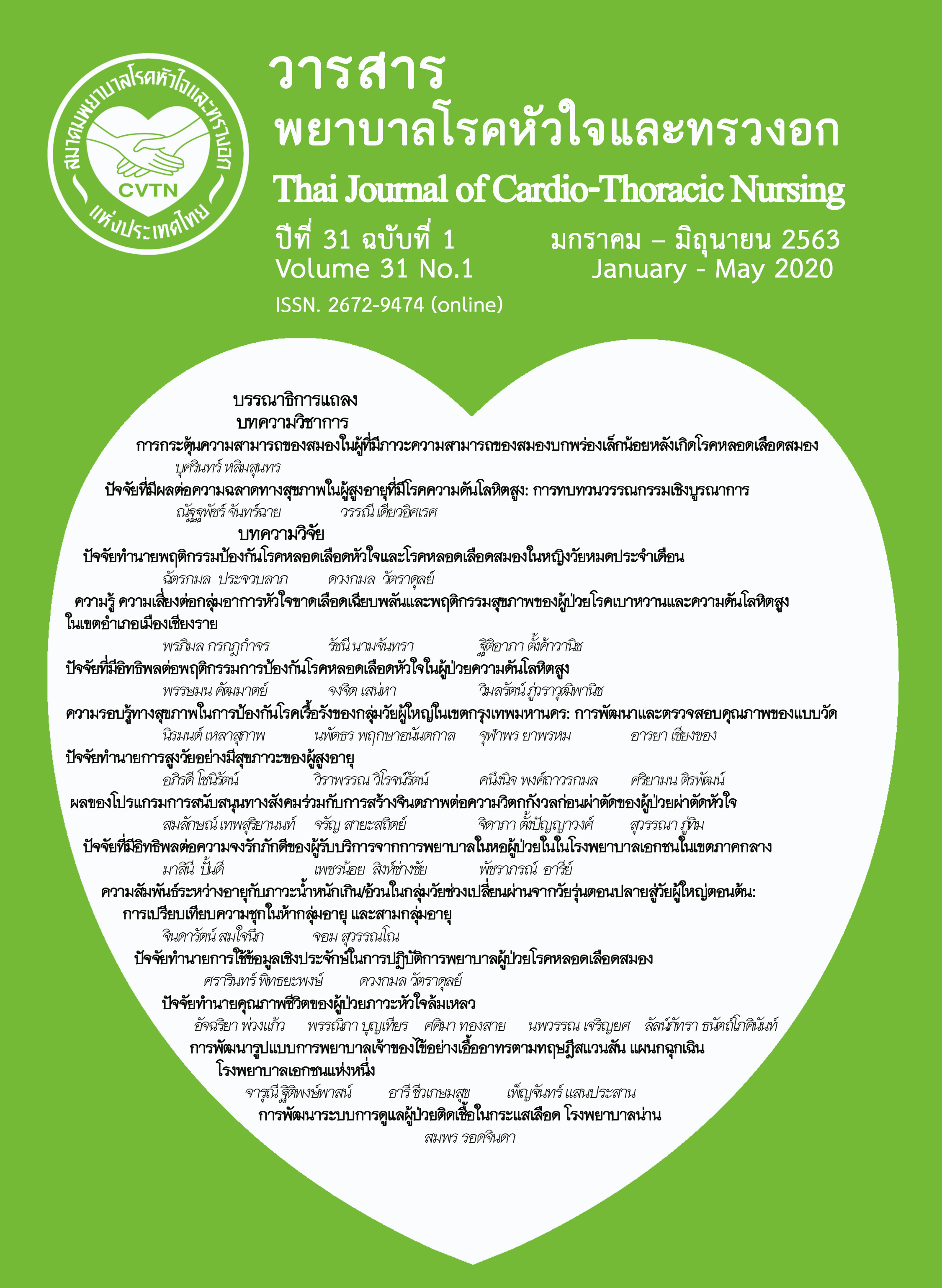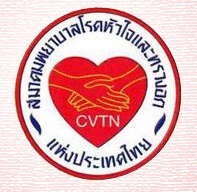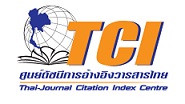การพัฒนาระบบการดูแลผู้ป่วยติดเชื้อในกระแสเลือดโรงพยาบาลน่าน
คำสำคัญ:
ผู้ป่วยติดเชื้อในกระแสเลือด, ระบบการดูแล, ผลลัพธ์การดูแลบทคัดย่อ
การวิจัยและพัฒนานี้มีวัตถุประสงค์เพื่อพัฒนาระบบการดูแลผู้ป่วยติดเชื้อในกระแสเลือดโรงพยาบาลน่าน เลือกกลุ่มตัวอย่างแบบเฉพาะเจาะจง ได้แก่ แพทย์ และพยาบาลวิชาชีพผู้ดูแลผู้ป่วยติดเชื้อในกระแสเลือดทั้งในโรงพยาบาลน่าน และโรงพยาบาลชุมชนในจังหวัดน่านจำนวน 50 คน และผู้ป่วย 60 ราย ที่แพทย์วินิจฉัยว่ามีภาวะ ติดเชื้อในกระแสเลือด แบ่งผู้ป่วยเป็น 2 กลุ่ม ได้แก่ ผู้ป่วยติดเชื้อในกระแสเลือดก่อนใช้ระบบการดูแล 30 คน และเป็นผู้ป่วยหลังใช้ระบบการดูแล 30 คน เครื่องมือที่ใช้ในการวิจัย ประกอบด้วย 1) แนวทางปฏิบัติในการดูแลผู้ป่วยติดเชื้อในกระแสเลือด 2) แบบตรวจสอบการปฏิบัติตามแนวทางการดูแลผู้ป่วยติดเชื้อในกระแสเลือด และ 3) แบบบันทึกข้อมูลผู้ป่วย การวิจัยแบ่งเป็น 3 ระยะ ได้แก่ 1) ระยะศึกษาสถานการณ์และสภาพปัญหา 2) ระยะพัฒนาระบบการดูแลผู้ป่วยติดเชื้อในกระแสเลือด นำไปทดลองใช้ ปรับปรุง และนำไปใช้กับผู้ป่วยที่แพทย์วินิจฉัยว่ามีภาวะติดเชื้อในกระแสเลือด 3) ระยะประเมินประสิทธิผลของระบบการดูแลผู้ป่วยติดเชื้อในกระแสเลือด วิเคราะห์ข้อมูลเชิงปริมาณโดยใช้สถิติเชิงพรรณนา และสถิติไคสแควร์ (Chi-Square) วิเคราะห์ข้อมูลเชิงคุณภาพด้วยการวิเคราะห์เชิงเนื้อหา
ผลการศึกษา พบว่า ระบบการดูแลผู้ป่วยติดเชื้อในกระแสเลือด โรงพยาบาลน่าน ประกอบด้วย 1) ระบบบริหารจัดการ 2) ระบบบริการ และ 3) ระบบเสริมสร้างศักยภาพบุคลากร ได้แก่ แพทย์ และพยาบาลวิชาชีพทั้งโรงพยาบาลน่าน และโรงพยาบาลชุมชน ผลการใช้ระบบการดูแลผู้ป่วยติดเชื้อในกระแสเลือด ผลลัพธ์ด้านผู้รับบริการพบว่า อัตราผู้ป่วยติดเชื้อในกระแสเลือดได้รับการคัดกรองในระยะเริ่มแรกเพื่อเข้าสู่กระบวนการรักษาเพิ่มขึ้น อัตราการเกิดภาวะช็อกจากการติดเชื้อ และอัตราตายของผู้ป่วยที่มีภาวะติดเชื้อในกระแสเลือดมีแนวโน้มลดลง ส่วนผลลัพธ์ด้านผู้ให้บริการพบว่าแพทย์ และพยาบาลวิชาชีพผู้ดูแลผู้ป่วยติดเชื้อในกระแสเลือดสามารถปฏิบัติตามมาตรฐานการดูแลรักษาได้เพิ่มขึ้น
ข้อเสนอแนะ: ระบบการดูแลผู้ป่วยติดเชื้อในกระแสเลือดในโรงพยาบาลน่านนี้สามารถนำไปใช้ในการดูแลผู้ป่วยได้อย่างมีประสิทธิภาพ จึงควรสนับสนุนให้มีความคงอยู่ต่อเนื่อง และขยายผลต่อไป
References
2. Dellinger RP, Levy MM, Rhodes A, Annane D, Gerlach H, Opal SM, et al. Surviving sepsis campaign: international guidelines for management of severe sepsis and septic shock: 2012. Crit Care Med. 2013;41(2):580-637.
3. Rudd KE, Johnson SC, Agesa KM, Shackelford KA, Tsoi D, Kievlan DR, et al. Global, regional, and national sepsis incidence and mortality, 1990-2017: analysis for the Global Burden of Disease Study. The Lancet. 2020;395(10219) :200-11.
4. Ministry of Public Health. The report of Mortality rate in patients with sepsis. Nonthaburi: Ministry of Public Health (MoPH); 2018. (in Thai).
5. Nan Hospital. Medical record and statistics of Nan Hospital 2018. Nan: Nan Hospital; 2018. (in Thai).
6. Treebupachatsakul P, Kamsawang N, Tuandeang P. Clinical outcome after application of CPG for sepsis. Buddhachinaraj Medical Journal. 2009;24 (1):33-45. (in Thai).
7. Mahantassanapong C. Outcome of the Surin sepsis treatment protocol in sepsis management. Srinagarind Medical Journal. 2012;27(4):332-39. (in Thai).
8. Punvittayakool J, Maneeprai J. The development of care model for sepsis. Journal of Nursing Division. 2018;45(1):86-104. (in Thai).
9. Onswadipong P, Sungkard K, Kusuma Na Ayuthya, Rongrungruan Y. The effect of early goal-directed nursing intervention on severity of organ failure in patients with sepsis syndrome. Journal of Nursing Science. 2010;29(2):102–10. (in Thai).
10. Jirakangwan M. Development of nursing model for severe sepsis in Sisaket Hospital Journal of Nursing Divition. 2015;42(3):9-32. (in Thai).
11. Deming WE. Out of the crisis. Massachusetts: Center for Advanced Engineering Study, Massachusetts Institute of Technology, Cambridge; 1982.
12. Pipatvet K. Predisposing factors of mortality in septic patients in Uttaradit Hospital. Thai journal of tuberculosis chest diseases and critical care. 2008;29(1):135-44. (in Thai).
13. Suranatchayanan P, Kenthongdee W, Kamonrat S. Nursing care system development for sepsis patients at Loei Hospital. Journal of Nursing and Health Care 2018;36(1):207-15. (in Thai).
14. Chairatana P. Journal of Nursing and Health Care. 2017;35(3):224-31. (in Thai).
15. Kutragoo R, Chantara P, Yimyam P, Khumpakum S, Namjuntra R. The development of a clinical supervision model for severe sepsis patients.Thai Journal of Cardio-Thoracic Nursing. 2019;30 (2); 193-209. (in Thai).
16. Regional Heath 1. Ministry of Public Health. Thailand. Sepsis data collection form and referral for sepsis patients. Retrieved May 19, 2020 from: https://www.sepnet1.com/login.php.
17. Lisa M. Adam L.Jonas T. Bertil C. John H. Boyd. Parham S. Per Å. Fredrik K. NEWS2 is Superior to qSOFA in Detecting Sepsis with Organ Dysfunction in the Emergency Department. J. Clin. Med. 2019; 8 (8), 1128.
18. Champunot R, Tansuphaswasdikul S, Kamsawang N, Tuandoung P, Thimsri D. Application of Search Out Severity (SOS) Score for Identification of Deteriorating Patients in General Wards. Buddhachinaraj Medical Journal, 2016; 33(3). 313-325. (in Thai).
19. Khwannimit B, Bhuraanontachai R, Vattanavanit V. Comparison of the accuracy of three early warning scores with SOFA score for predicting mortality in adult sepsis and septic shock patients admitted to intensive care unit. Heart Lung. 2019; 4(83), 240-244.
20. Kowtragool N. Effects of Using a Case Management System to improve the quality of care for the Sepsis Patients in Sakaeo Crown Prince Hospital. Thai Journal of Cardio-Thoracic Nursing. 2014;25 (2); 120-134. (in Thai).
21. Potisita C. Science and art of quality research (5th edition). Bangkok: Amarin Printing and Publishing Public Company Limited; 2554. (in Thai).
22. The Thai Society of Critical Care Medicine. Clinical practice guidelines for severe sepsis and septic shock (draft) 2558. Retrieved January 19, 2020 Searched from http://www.sepsiseasy. com/.
23. Noparith P. A Development of Nursing Care Model for Sepsis patients in Mukdahan Hospital. Journal of Nursing and Health Care.2019; 31(1); 221-230. (in Thai).
Downloads
เผยแพร่แล้ว
How to Cite
ฉบับ
บท
License
บทความนี้ยังไม่เคยตีพิมพ์หรืออยู่ในระหว่างส่งไปตีพิมพ์ในวารสารอื่น ๆ มาก่อน และกองบรรณาธิการขอสงวนสิทธิ์ในการตรวจทาน และแก้ไขต้นฉบับตามเกณฑ์ของวารสาร ในกรณีที่เรื่องของท่านได้ได้รับการตีพิมพ์ในวารสารฉบับนี้ถือว่าเป็น ลิขสิทธิ์ของวารสารพยาบาลโรคหัวใจและทรวงอก





